Alo called : urucum, açafrão , açafroa , açafroeria-de-terra (Brazil), axiote (Mexico), bija (Peru, Cuba), santo-domingo (Puerto Rico), urucu (Argentina, Bolivia), bixa (Guyana), analto (Honduras), onotto, onotillo (Venezuela), guajachote (El Salvador), lipstick tree
Achiote is a Yucatecan spice obtained from the seeds of the Bixa orellana shrub/tree. Achiote held a sacred function for the Mayas and Aztecs as an extract of the plant was regarded as a symbolic substitute for blood (1). It was also used to create an ink that was used in writing the codices of the Maya. Its common name “lipstick tree” points to its cosmetic use as a lip colourant, it was also used as a hair dye.
- Ravindran, P. N. (2017). The encyclopedia of herbs and spices.
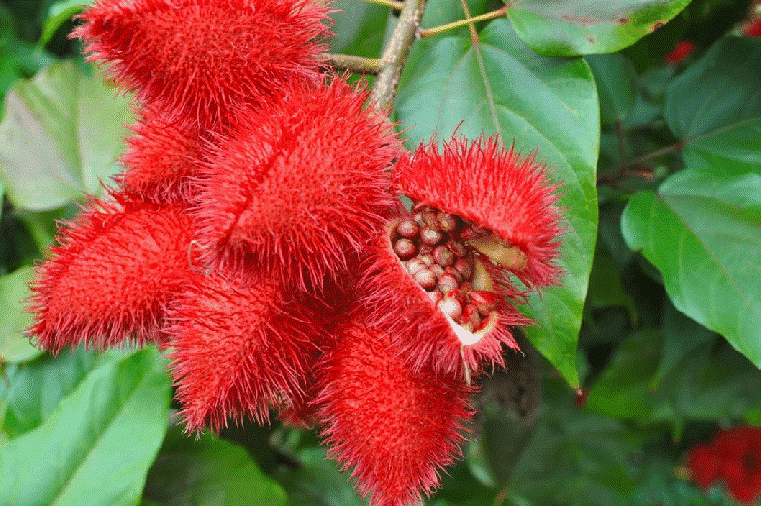
Annatto is a plant from South America, more specifically of the Amazon region. It is native to Brazil but grows in other regions of South and Central America. It is grown in tropical countries such as Peru, Mexico, Ecuador, Indonesia, India, Kenya, and East Africa. Several species of this plant exist with the most common variety being Bixa orellana L., named after Francisco Orellana, who was the first European to navigate the Amazon. It was taken to the Philippines in the 17th century by Spanish colonials from Central America and the West Indies.
Annatto (E160B) has become popular in food manufacturing as an alternative to the known allergenic artificial colours, Tartrazine E102 and Sunset Yellow E110. Annatto is used primarily as a colouring in fish, rice and vegetable dishes. It is the base of approximately 70% of all natural food colourings consumed worldwide.
Annatto was used to colour and flavour the cacao drinks of the Maya and the Aztecs. Its most famous traditional application is in the making of achiote paste, an important ingredient in Mexican cooking. The Mexicans utilise annatto to colour and flavour their stews, sauces and tacos.
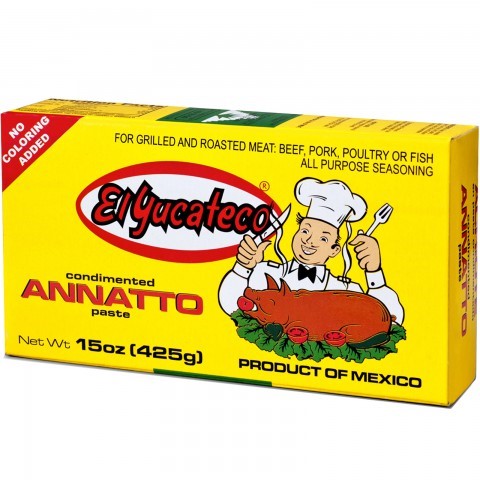
Recado Rojo
(Red Achiote Paste)
Ingredients:
- 1 1/2 tablespoons achiote/annatto seeds
- 1/2 tablespoon coriander seeds
- 1/2 tablespoon black peppercorns
- 1/2 teaspoon cumin seeds
- 3 whole cloves
- 2 teaspoons dried oregano
- 5 cloves garlic
- 1 teaspoon salt
- 1-2 tablespoons white wine vinegar, or Seville orange juice
Method:
Grind the first 6 ingredients to a powder. Achiote seeds are very hard, so it will take a little time. Crush the garlic with the salt in a mortar, then gradually work in the ground spices. A hot red chili pepper could be added; crush it with the garlic. Moisten with the vinegar or bitter orange juice so that you have a smooth paste.
Form the paste into small disks or balls and let them dry, or put the paste into an airtight container to dry. Whether dried, or as a paste, the recado will keep for several months if refrigerated.
To use, mix with more Seville orange juice to thin it down and make a marinade

Pollo Pibil (Roast Chicken Yucatan Style)
Ingredients
Marinade
- 1 cup (sour) orange juice
- ½ cup fresh lime juice
- 2 Tablespoons white vinegar
- 2 Tablespoons achiote paste
- 3 cloves garlic
- 1 teaspoon white [pepper
- 1 teaspoon ground cumin
- 1 teaspoon Mexican oregano
- ¼ teaspoon ground cinnamon
- Salt – to taste
The Chicken
- 1 x 4kg (7-8lb) Chicken cut into sections (or you could use just legs for ease of service and portion control)
- 5 large pieces fresh banana leaf or aluminium foil cut into 30cm squares.
- 1 Large tomato cut in slices
- 1/2 white or red onion cut in thin slices
- 6 epazote leaves (optional)
- Salt and pepper to season
Method
- Blend all of the ingredients for the marinade and set aside.
- Place chicken in a large glass bowl and cover with the achiote marinade. Marinate for at least 1/2 hour (or overnight) in the refrigerator.
- To soften banana leaves, place on preheated griddle or comal at medium heat or run briefly through an open flame. Heat for 20-25 seconds per side. They will change colour slightly and become shiny.
- Place the banana leaves in a crisscross shape on a large, heavy baking sheet or on squares of aluminium foil if using. Reserve a leaf for service.
- Place one piece of chicken in the centre of the banana leaf, spoon on some of the marinade sauce, and garnish with a slice of tomato, some slices of onion and 1 epazote leaf (if using). Season with salt and pepper.
- Wrap the chicken with the banana leaves. You can either use only aluminium foil for this step If you have no banana leaves), banana leaves, or both. If you are using frozen banana leaves they will not fold without breaking like fresh leaves will, just place the leaf onto a square of aluminium foil, add the chicken and marinade as noted above and fold. The banana leaf will still impart some flavour if used this way.
- Bake the chicken in an oven preheated to 230ºC (450ºF) for about 30 minutes per kg (2lbs) or cook in a steamer for about the same length of time.
Serve the chicken on the reserved banana leaf and with warm tortillas, white rice and pickled red onions (see recipe below)
Yucatecan Pickled Onions
Ingredients
- 2 large red onions sliced about 3mm (1/8) inch thick
- 2 cloves garlic cut in half
- 1 1/4 cups cider vinegar
- 1 1/4 cups water
- 1 clove
- 5 allspice berries whole
- 1/4 tsp black peppercorns whole
- 3 Tbsp sugar
- 1 tsp salt
Method
- Bring all ingredients except the onions to a boil in a saucepan large enough to hold the onions.
- Add the onions and cook for 1 minute.
- Remove from heat and let cool to room temperature, stirring occasionally.
- Store in a sealed jar in the fridge.
- Let the onions stand for at least 4 hours or overnight before serving
- Drain onions and serve.
Medicinal Uses of Annatto
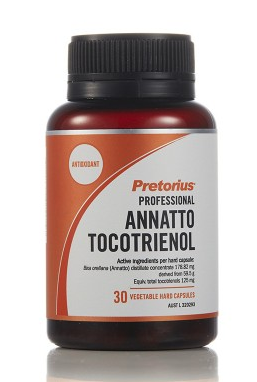
All parts of this plant can be used medicinally. The roots, leaves, seeds and seed casings have been used to treat various ailments.
Traditional use.
This plant has been used to treat conditions such as kidney problems, measles, smallpox, stomach disorders, burns and blisters, sore throat, bronchitis, tonsillitis, fever, diarrhoea, haemorrhoids, hypertension, vaginal and skin inflammations, prostatitis, conjunctivitis, abscesses, respiratory problems, vomiting, headache and wounds.
Leaves have been used to treat pulmonary and respiratory disorders, digestive pain and dysentery and have found some use in the treatment of hepatitis and gonorrhoea.
Seeds are used primarily as an aromatic and colouring in cooking but are also used as a diuretic, an antipyretic, an astringent, to treat coughs and colds, to help relieve labour pains and also to treat diabetes. An insect repellent can also be obtained from the seeds.
The roots are used to treat gonorrhoea, diabetes and to remove intestinal parasites.
Constituents
Seeds : aldehydes, alkanes, alkenes, ketones, esters, carotenes (Beta-carotene, bixin, cryptoxanthin, geranylgeraniol, lutein, norbixin, phytoene, phytofluene, trans-bixin, zeaxanthin, isobixin, orellin, bixein, bixol, crocetin), ishwarane (a tricyclic sesquiterpene hydrocarbon), ellagic acid, salicylic acid, threonine, tomentosic acid, tryptophan, phenylalanine, tannins, saponin, monoterpenes (geraniol, linalool)
Leaves: flavonoid bisulfates, sterols, tannins, saponins, and an essential
oil comprising mainly sesquiterpenes with ishwarane as
the major compound, carbohydrates, steroids, alkaloids, proteins, flavonoids, terpenoids, phenolics, tannins, glycosides
Roots: triterpene (tomentosic acid), bixaghanene, bixein,
bixol, crocetin, ellagic acid, isobixin, phenylalanine, salicylic
acid, threonine and tryptophan
Actions
Seeds : Antidiabetic, antidiarrhoeal, anti-gonorrheal, antihyperlipidaemic, antileishmanial, antimalarial, antioxidant (attributed to norbixin), antipyretic, aromatic, cardiotonic, condiment, cytotoxic, diuretic, dye, expectorant, hypoglycaemic, hypotensive, insecticide, laxative
Fruit pulp : wound healing, cicatrisant, also used in a drink to treat dysentery and kidney infection
Leaf : anti-inflammatory, antidiabetic, antidysenteric, antiemetic, antifungal, antimicrobial, antipyretic, antivenom (1), anodyne (headaches), disinfectant, diuretic, insect repellant, ophthalmic, pulmonary, stomachic
- An ethanolic extract of leaves was shown to
neutralize the defibrinating and coagulant effects of venom and
to reduce oedema resulting from Bothrops atrox (a species of
poisonous pit viper) venom. Achiote leaf extract also caused
45–80% neutralization of enzymatic effects of the venom (Otero, R., Núñez, V., Jiménez, S.L., Fonnegra, R., Osorio, R.G., García, M.E. and Díaz, A. (2000) Snakebites and ethnobotany in the northwest region of Colombia: Part II: neutralization of lethal and enzymatic effects of Bothrops atrox venom. Journal of Ethnopharmacology 71, 505–511.)
Bark/stems : anti-diarrhoeal, antidysenteric, anti-emetic, bactericidal, emmenagogue
Root : antiasthmatic, antidiabetic, anti-gonorrheal, hepatic
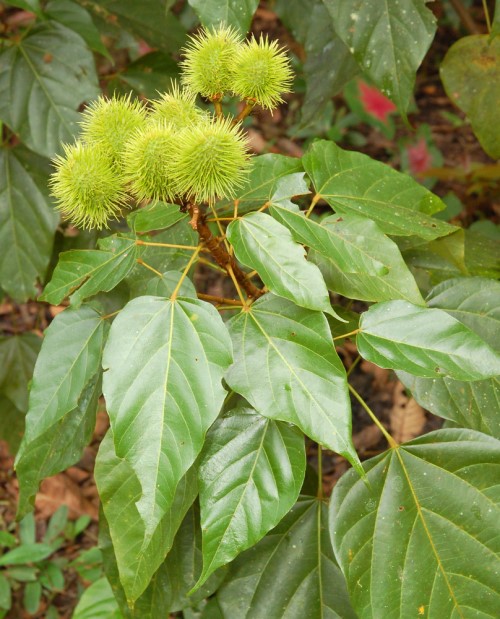
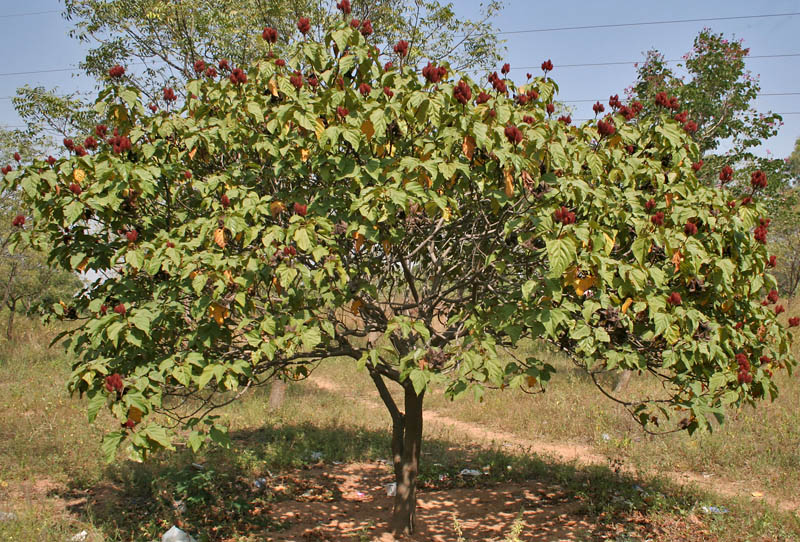
According to studies laxative, cardiotonic, hypotensive, expectorant, and antibiotic attributes have been ascribed to this plant. In addition oil obtained from this plant has anti-inflammatory activity for bruises and wounds and has been used for the treatment of bronchitis and for wound healing purposes.
In-vitro testing has found that a seed extract was both antileishmanial (against Leishmania amazonensis) and antimalarial (against Plasmodium berghei and falciparum). Seed extracts also demonstrated hypoglycaemic activity and were effective at treating hyperlipidaemia. There was also a potential hypotensive activity demonstrated. The seed extract was also found to be cytotoxic against cancer cells when tested in-vitro. The leaf extract was found to have antigonorrheal activity.
Safety
Extracts of this plant have been found to be very safe. The LD50 (in mice) is greater than 700mg/kg (as a comparison, in mice caffeine has an LD50 of 192mg/kg and nicotine is 3.34mg/kg). There have been no reported adverse effects when using this plant while pregnant.
Caution should be taken if you are diabetic or on diabetic medications as annatto may affect blood sugar levels. Culinary use should not present a problem but if being used medicinally then monitor blood sugar levels carefully.
Uses
Poultice:
The pulp can be used as a poultice on damaged skin and wounds. A paste made from the seed will accelerate the healing process and reduce scarring. It will stain the skin red. A poultice of boiled leaves can be placed on the head to treat fever while a poultice of leaves pounded with a little coconut oil may work as a headache treatment. A leaf poultice is also used topically for gonorrhoea.
Decoction:
The decoction is made by simmering 10 achiote leaves in 1 litre of boiling water for 15 minutes. It is then filtered and can be used as a wound wash, an eye wash, a gargle for mouth and throat infections or a vaginal douche. It can be used several times a day. this leaf decoction can also be used as an anti-emetic during pregnancy.
Infusion:
- An annatto infusion is prepared with the shell that has around the seed. 20 grams of shell are used for each litre of water. Drink 2 or 3 cups a day.
- The leaf infusion can also be used as an insect repellent and has shown to be effective against bronchitis, sore throat and eye inflammation.
- A bark/leaf infusion is used for stomach-ache, dysentery, nausea, vomiting, stomach problems and acid reflux.
- An infusion of small stems and bark may also be used to promote menstrual flow and alleviate menstrual pain.
- Castello, M.C., Phatak, A., Chandra, N. and Sharon, M. (2002) Antimicrobial activity of crude extracts from plant parts and corresponding calli of Bixa orellana L.
Indian Journal of Experimental Biology 40, 1378–1381. - Daniela de Araújo Vilar, Marina Suênia de Araujo Vilar, Túlio Flávio Accioly de Lima e Moura, et al., “Traditional Uses, Chemical Constituents, and Biological Activities of Bixa orellana L.: A Review,” The Scientific World Journal, vol. 2014, Article ID 857292, 11 pages, 2014. https://doi.org/10.1155/2014/857292.
- Kovary, K., Louvain, T.S., Costa e Silva, M.C., Albano, F., Pires, B.B., Laranja, G.A., Lage, C.L. and Felzenszwalb, I. (2001) Biochemical behaviour of norbixin during in vitro DNA damage induced by reactive oxygen species. British Journal of Nutrition 85, 431–440.
- Oboh, G., Akomolafe, T.L., Adefegha, S.A. and Adetuyi, A.O. (2011) Inhibition of cyclophosphamide-induced oxidative stress in rat brain by polar and non-polar extracts of annatto (Bixa orellana) seeds. Experimental Toxicology and Pathology 63, 257–262.
- Pino, J.A. and Correa, M.T. (2003) Chemical composition of the essential oil from annatto (Bixa orellana L.) seeds. Journal of Essential Oil Research 15, 66–67.
- Priyanka, V., Kumaran, K. and Vinothini, B. (2017). Analysis of bioactive constituents from selected genotypes of annatto seed extract through Gc-Ms. Agric. Update, 12(TECHSEAR-1) : 173-177; DOI: 10.15740/HAS/AU/12.TECHSEAR (1) 2017/173-177.
- Radhika, B. and Nasreen Begum, S.K. (2010) Pharmacognostic and preliminary phytochemical evaluation of the leaves of Bixa orellana. Pharmacognostic Journal 2, 132–136.
- Shilpi, J.A., Taufiq-Ur-Rahman, M., Uddin, S.J., Alam, M.S., Sadhu, S.K. and Seidel, V. (2006) Preliminary pharmacological screening of Bixa orellana L. leaves. Journal of Ethnopharmacology 108, 264–271.
- Vilar, D. de A., Vilar, M.S. de A., de Lima e Moura, T.F.A., Raffin, F.N., De Olivera, M.R., Franco, C. f. de O., De Athyde-Filho, P.F., Melo Diniz, M.F.F. and Barbosa Filho, J.M. (2014) Traditional uses, chemical constituents, and biological activities of Bixa orellana L.: a review. The Scientific World Journal (http://dx.doi.org/10.1155/2014/857292) accessed 27 March 2017.
- Yoke Keong, Y., Arifah, A.K., Sukardi, S., Roslida, A.H., Somchit, M.N. and Zuraini, A. (2011) Bixa orellana leaves extract inhibits bradykinin-induced inflammation through suppression of nitric oxide production. Medicinal Principles and Practice 20, 142–146.

